Point-block Low-Rise Low-Cost Apartments

Most walk-up apartments in Malaysia can be described as slab blocks. In a paper written in 2000 I argued that the point block low rise apartment is not only more aesthetically pleasing and socially functional, it is also an economically viable alternative.
In the previous six years, my firm, Arkitek M Ghazali, had attempted to design low cost and low-medium cost housing that met the strict cost limits required by developers, the rules set by government authorities, and the same time achieve the aesthetic and social aims of my practice.
My firm approached this problem by designing and refining generic designs capable of being applied across the various sites, requirements and parameters of different projects. I particular, we promoted the point-block low-rise apartment as a generic design which is superior to the ubiquitous slab block low rise apartment.
The Economic Advantages of Point Block Low Rise Apartment Compared to the Slab Block Low Rise Apartment
The slab block low-rise (walk-up) apartment is the standard solution in big towns and cities in Malaysia. The typical design comprises four or five storeys of apartments strung out in two lines opposite each other with access corridors and voids in the middle, and staircases at both ends of the corridor.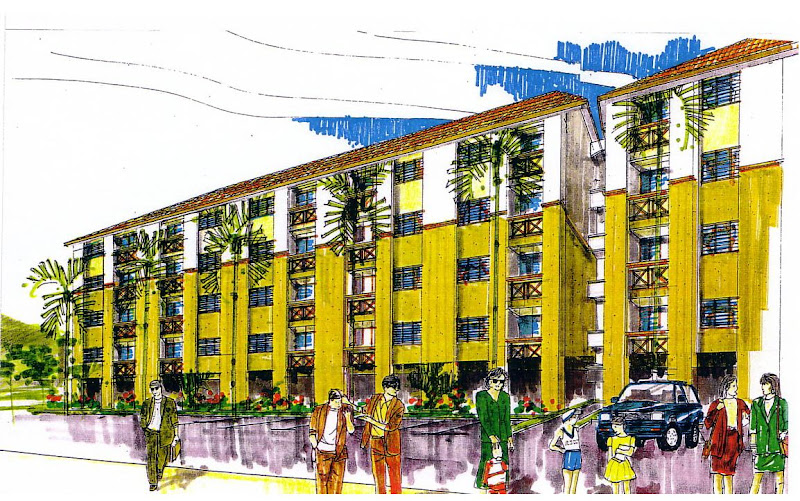
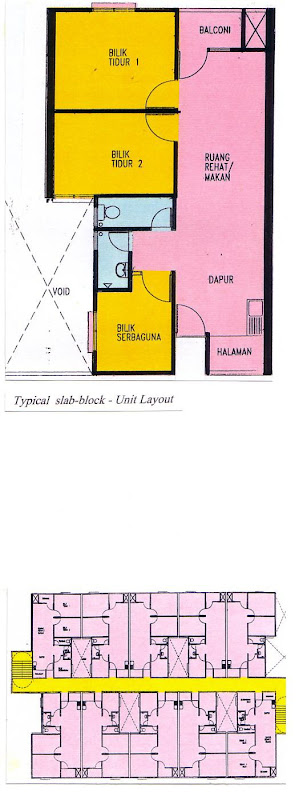
There are of course many variations to this basic concept. We just have to adapt specific dimensions and layout to customize the design. The slab block, in my opinion is not very pleasing aesthetically, and in social terms, now too positive either. Its main advantage is that it is cheap. Certainly it is cheap compared to terrace houses or bungalows because it use less land, Typically 50 to 60 units / acre compared to 20 units / acre for terrace house and even less tor bungalows. The construction cost for unit is also low compared to the bungalow or terrace house because there are lots of shared walls, shared structure, floors and roofing.
Against to the point-block, the slab block certainly looks cheaper. And therefore it is cheaper goes the implicit commonsense logic. The purpose of this paper is to challenge that common sense conclusion.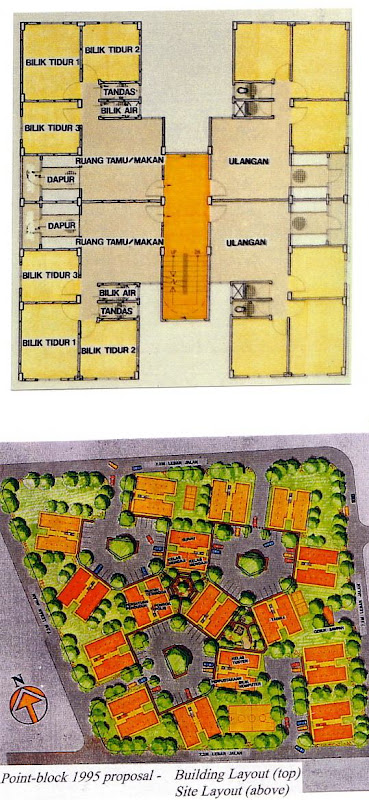
The point block walk-up apartment comprises a single staircase in the core and four or more units around that central staircase. Every unit is a corner unit. The point blocks that we’ve designed certainly do not look cheap but there are specific and verifiable reasons why point blocks are cost-effective:
Density (units/acre)
Land is an important cost factor in housing. Commonly it is 10% - 20% of the total development cost of a mixed housing project. The accepted density for low-cost low rise apartments (in most States in Malaysia )is 60 units/acre. lt is not easy to achieve this density in an aesthetically pleasing and socially acceptable manner. You can maximise units for any given plot of land by using bigger blocks. Right? Well, not always true.
It you have two similar round vessels of say 1 cubic meter capacity each and fill one vessel with large stones and the other vessel with small pebbles which vessel would contain more material? The vessel with the small pebbles will have more material. There would be less spaces between the pebbles compared with the bigger stones. In a similar manner, small blocks can fill up a site better than standard slab blocks. This tends to be true for big sites, especially sites with irregular shape. In the case of small sites, blocks designed to the shape of the land do better.
Space efficiency (net sellable area / gross area):
Small point blocks are more efficient compared to slab blocks. In particular the corridor is eliminated and the staircase and landing area is minimal. It is usual for point blocks to have 60% or less of corridor and staircase space per unit. It is not in typical for slab block with double loading corridors' to have 76sf (7sm) external circulation space per unit. Slab block with single loading corridors can have external circulation space 96sf (9sm) or more per unit. Architects sometimes think that the more units share staircases, the more cost effective the design, but the corridors that lead to the staircases also add cost.
Internal layout efficiency
This is about maximising space usage in units. In the point block generic design, every unit is a corner unit. There is a cost penalty tor this - there is less shared walls between units and there is less shared beams and columns. However there is a benefit - less shared walls means more external walls, and with more external walls for light and ventilation it is easier to design efficient and functional rooms. In our point block designs we try to maximise usable space and minimise circulation space. In intermediate units of slab blocks, external wall is at a premium. Voids have to be cut out in the interior of the block to provide windows to receive what little light and ventilation these air wells can provide. Or else, the exterior elevations require deep indents to bring in light and ventilation to the middle areas.
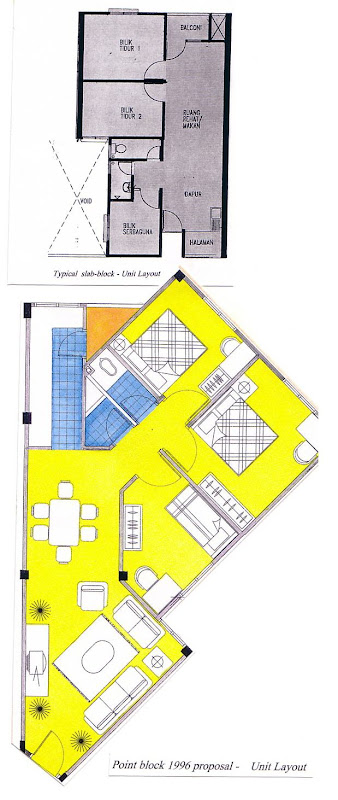
The depth of the units, often long in relation to the width, results in long circulation spaces required to access the outer rooms. This layout also involves other substantial compromises in functional design. Firstly, entrances are invariably at the dining area near the kitchen. This is not functional but seems to be the accepted standard even for medium to high cost apartments. Secondly, there will be some bedrooms, the kitchen, drying yard and some toilets which will have to make do with light and ventilation from air wells. Thirdly, entering the apartment from where the kitchen and drying yard is situated creates the impression of entering a home from its backyard. Fourthly, bedrooms are difficult to cluster together in a private zone separate from the semiprivate living and dining areas.
We have found that with point -blocks that have square plan-forms and ample external walls, the abovementioned compromises can be overcome circulation space can be minimised. In fact corridors can be eliminated.
Block footprint
One of the reasons why the point block is able match the density of the slab block is its efficient footprint, There are no internal voids, and the generally we aim for shapes that fit well in a circle. But a small footprint has its own rewards. This has to do with earthworks and the building foundation. Blocks with small footprints require small earth platforms. Blocks with big footprints require larger earth, platforms. A series of small earth platforms generally involve less volume then a series of larger platforms cut out from the same original slope profile.
From the same illustration it is also intuitively clear that easier to arrange point blocks to sit on cut ground than it is to arrange slab blocks to meet this same requirement. Having original ground to sit on rather than fill ground can save a lot in foundation costs. Of course slab blocks can be arranged along contours to minimise earthworks, though this limits the flexibility of the layout and is not effective where the land slope in two directions. Another possibility is to stagger the slab block down the slope, this requires retaining walls or stilts which again adds cost, and reduces standardisation.
Therefore it can be said that generally point blocks with smaller footprints than slab blocks provide greater flexibility in external layout design, requiring less earthworks and lower foundation costs.
CONCLUSION
The majority of low cost flats in Malaysia can be described as slab block low-rise apartments. The ubiquity of this generic design, despite its functional and social inadequacies can be attributed to the misconception that, given the cost constraints there are no alternatives. But Low-rise point blocks in my opinion through more aesthetically pleasing, functional and socially acceptable can be more cost effective when compared to the slab block.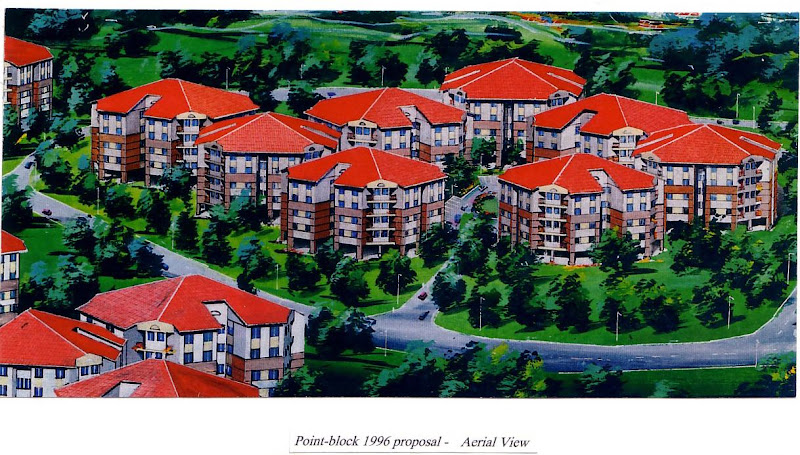
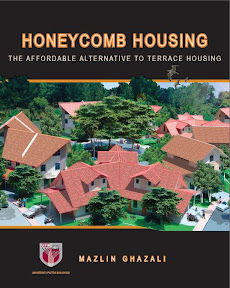

4 comments:
People should read this.
This is great..
I'm doing a low cost housing design as well.
Can you elaborate on interlocking units the unite de habitation by le corb? Is it possible to integrate such idea with yours?
Unite d'Habitation featured a long corridor with two rows of maisonettes (ie double storey apartments) on each side. The corridors serve as circulation space.
In the early versions of my point block idea, I tried to minimize the size of the central staircase and lobby to save cost. Now I make these lobbies bigger so that they become not only circulation space, but also a communal area. Especially, as an outdoor play area for pre-school children.
I am Property developer in Lagos Nigeria very excited about point block low rise apartments.Would like make enquires into building snd design of such buildings in Lagos
Post a Comment